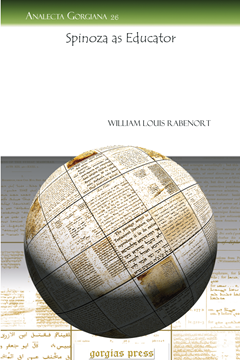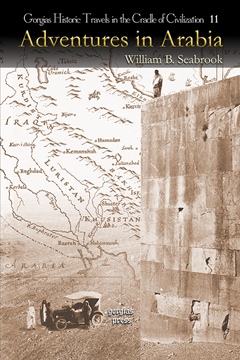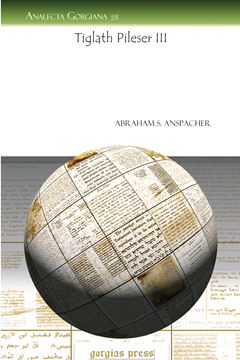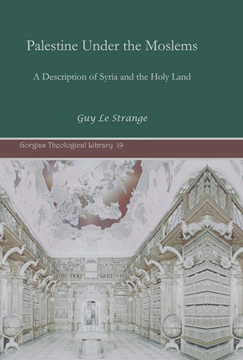Spinoza as Educator
Series: Analecta Gorgiana 26
ISBN: 978-1-59333-589-2
When educator William Rabenort looked at Spinoza he saw an educator. This little book on educational theory is built on the thought of Spinoza.
$52.00 (USD) $31.20 (USD)
Sidon
A Study in Oriental History
ISBN: 978-1-59333-592-2
Although the name of "Sidon" is familiar to readers of the Bible, few know much about it. In this seminal study of the city of Sidon the reader is taken through what can be known of the political history and cultural influence, ancient and present, of this important city.
$130.00 (USD) $78.00 (USD)
Studies in Oriental Social Life
and Gleams from the East on the Sacred Page
Series: Kiraz Theological Archive 32
ISBN: 978-1-59333-596-0
Trumbull’s tome was among the first to explore how looking at the Bible from the perspective of those in Palestine might influence the outlook of Western readers. In this volume Trumbull examines the social customs, religious practices, and basic concepts of those living in nineteenth-century Palestine to demonstrate how they bear upon modern understandings of the Bible.
$195.00 (USD) $117.00 (USD)
Adventures in Arabia
Among the Bedouins, Druses, Whirling Dervishes, and Yezidee Devil Worshipers
Series: Kiraz Historic Travels Archive 11
ISBN: 978-1-59333-597-7
In this personal travelogue, William Seabrook chronicles his adventures in the Middle East in the early part of the twentieth century. Specifically he focuses on his time among four Arabic groups: the Bedouins, Druses, Dervishes, and Yezidees.
$178.00 (USD) $106.80 (USD)
Tiglath Pileser III
Series: Analecta Gorgiana 28
ISBN: 978-1-59333-598-4
The historic first attempt to provide a succinct account of the reign of the founder of the Neo-Assyrian Empire, Anspacher’s monograph has stood the test of time. Written in accessible form, this brief account of a king, notorious by biblical standards, will be welcomed by all who are interested in the history of the Middle East.
$49.00 (USD) $29.40 (USD)
Winters in Algeria
Series: Kiraz Historic Travels Archive 2
ISBN: 978-1-59333-599-1
In the 1870s, American painter Frederick Bridgman traveled from his home in Paris to Algiers. Although he traveled to paint, his journeys so impressed him that he produced a written account that appeared in “Harpers Monthly.” That account became the basis of this book. His travelogue describes the people and customs, the layout of the towns, the celebration of the Muslim religion, the black community in an Islamic context, and the legends of the people of historic Algeria.
$150.00 (USD) $90.00 (USD)
The Cosmic Covenant (Hardback)
Biblical Themes of Justice, Peace and the Integrity of Creation
ISBN: 978-1-59333-604-2
Murray’s study of the covenant theme begins with a chronological survey of the concept, beginning at the creation itself. He traces this theme through the Bible, noting its key components of justice and peace. The concept is a shared one between Judaism and Christianity, and Murray suggests that it continues to have ecological as well as spiritual relevance to the world today.
$150.00 (USD) $90.00 (USD)
Palestine under the Moslems
A Description of Syria and the Holy Land
Series: Kiraz Theological Archive 19
ISBN: 978-1-59333-606-6
This detailed study of the physical layout and traditions of the Holy Land and Syria contains an enormous amount of detailed information. For readers who wish to correct their vision of the actual physical geography of Syro-Palestine, this work remains a recommended source.
$244.00 (USD) $146.40 (USD)
Nebuchadnezzar’s Dream or The End of a Medieval Catholic Church
ISBN: 978-1-59333-583-0
The Catholic Church of the Third Millennium has retained many of its medieval images and formulations making its message incomprehensible for modern people. The book suggests different ways for modern Catholics to speak about Scripture, hierarchy, Jesus, the afterlife, sacraments, sin, redemption, sacrifice, supplicating prayer and other issues. His study seeks to be a faithful translation, advanced by modernity, of the same message that was previously transmitted in traditional medieval language.
$94.00 (USD) $56.40 (USD)
Catalogue of Syriac Printed Books and Related Literature in the British Museum
By Cyril Moss
Series: Kiraz Historical Catalogues Archive 2
ISBN: 978-1-59333-607-3
Moss’s catalogue represents the first effort at providing a thorough, printed database of the various materials that make up the British Museum’s Syriac corpus. The catalogue includes not only Syriac manuscripts, but also a listing of books and articles concerning them.
$368.00 (USD) $220.80 (USD)









